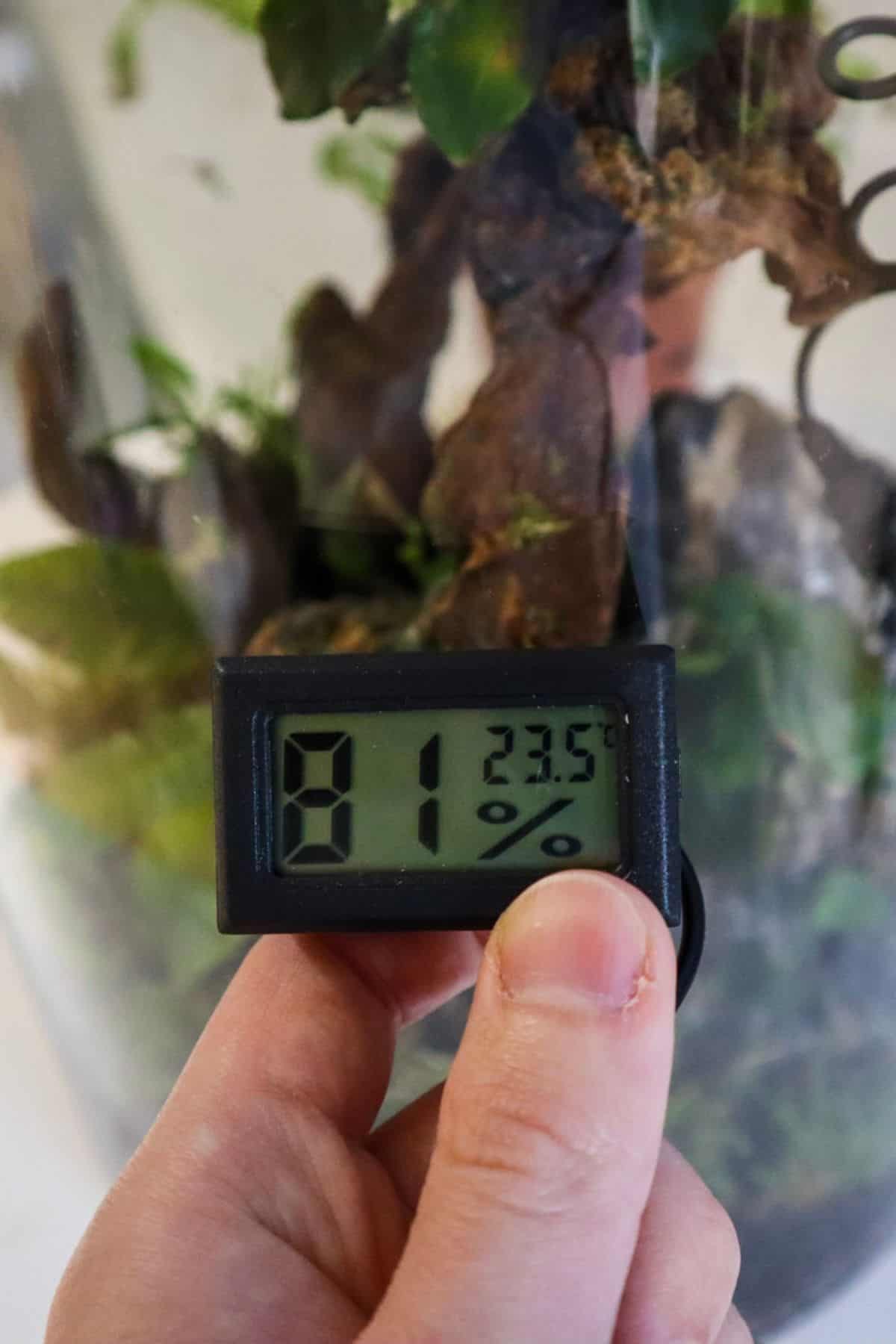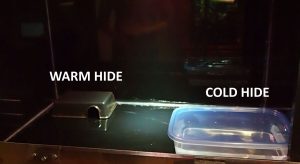Increase humidity in a terrarium by misting the container with water regularly. Terrariums are charming mini ecosystems that can host a variety of plants and small animals.
However, maintaining the optimal humidity level in a terrarium can be a challenge. Adequate humidity is crucial for the health and survival of the plants and animals inside. If the humidity is too low, the plants may wither, and the animals may suffer from dehydration.
Fortunately, there are simple yet effective ways to increase humidity in a terrarium. This article will discuss various methods that you can follow to ensure the ideal humidity for your terrarium, allowing your plants and animals to thrive in their enclosed habitat.

Credit: terrariumtribe.com
The Role Of Humidity In Maintaining A Healthy Terrarium Ecosystem
The role of humidity in maintaining a healthy terrarium ecosystem is crucial. Humidity directly impacts plant growth by providing the necessary moisture for their development. Inadequate humidity levels can hinder plant growth and cause wilting or even death. Additionally, humidity is equally important for animal inhabitants in a terrarium. Reptiles, amphibians, and other creatures require specific humidity levels to thrive and maintain their health.
Low humidity can lead to problems such as dehydration, shedding issues, or respiratory infections for these animals. It is essential to monitor and adjust humidity in a terrarium to avoid these common issues. Consider using a hygrometer to measure humidity levels accurately and provide the needed moisture through misting or using a humidifier. Maintaining optimal humidity levels will contribute to a flourishing terrarium ecosystem.
Encouraging Moisture Retention In The Substrate
Increase the humidity in your terrarium by following these simple steps. Start by selecting the right substrate that encourages moisture retention. Opt for substrates such as coconut coir or sphagnum moss, as they have excellent water retention properties. Incorporate water-absorbing materials like perlite or vermiculite into the substrate to further enhance moisture retention.
To dampen the substrate effectively, try misting it with water using a spray bottle. Ensure that the substrate remains damp but not saturated. Another technique is to create a humidity chamber by covering a small area of the terrarium with plastic wrap or a glass lid. This traps the moisture and increases the humidity within that specific area.
How to Increase Humidity in a Terrarium: Step by Step Guide
Creating A Moisture-Rich Environment
Creating a moisture-rich environment in a terrarium is crucial for the well-being of its inhabitants. One effective method is positioning the terrarium in a humid location, such as the bathroom or near a kitchen sink, where moisture levels are naturally higher. Another option is to utilize a glass lid or plastic wrap to trap moisture within the terrarium. This helps to maintain a higher humidity level by preventing the evaporation of moisture.
Additionally, grouping plants together within the terrarium can increase humidity through transpiration. Plants release moisture through their leaves, increasing the overall humidity within the enclosure. Remember to choose plants that thrive in humid conditions and monitor the humidity levels regularly using a hygrometer. By following these tips, you can successfully increase the humidity in your terrarium and provide a healthy habitat for your plants and animals.
Misty Mornings And Evening Showers
Maintaining the right humidity level in your terrarium is crucial for the well-being of your plants and animals. Regular misting routines play a vital role in achieving optimal humidity conditions. To ensure your terrarium stays adequately moist, using a spray bottle is a simple yet effective method. By misting your terrarium, you simulate the natural dew that occurs in the morning and evening, creating a comfortable environment for your terrarium’s inhabitants.
Scheduling your misting sessions strategically is essential for humidity control. Each terrarium may have different requirements, so it’s important to take into consideration factors such as temperature, ventilation, and plant and animal needs. Experiment with misting duration and frequency to find the right balance for your terrarium.
Employing A Terrarium Fogger System
Employing a terrarium fogger system is an effective way to increase humidity levels in your terrarium. Understanding how a terrarium fogger works is important before deciding to use one. Foggers utilize ultrasonic technology to create a fine mist that disperses throughout the enclosure, raising humidity levels.
There are several benefits to using a fogger in your terrarium. Firstly, it helps create a suitable environment for moisture-loving plants and animals, promoting their health and well-being. Additionally, a fogger can save you time and effort by automating the humidity control process.
When selecting a fogger, be sure to consider the size of your terrarium. Different models are designed to accommodate various enclosure sizes, so choose one that suits your needs. It’s also crucial to maintain the fogger properly and clean it regularly to prevent the growth of harmful bacteria or mold.
| Benefits of Using a Terrarium Fogger | Considerations for Selecting a Fogger |
|---|---|
|
|
Using A Humidifier For Larger Terrariums
Increasing humidity in a terrarium is crucial for maintaining a healthy environment for your plants and animals. One effective way to achieve this is by using a humidifier, especially for larger terrariums. However, it is essential to determine the appropriate size of the humidifier to ensure it meets the needs of your terrarium. The size of the humidifier should be based on the terrarium’s dimensions, specifically the volume of the enclosure. Placing the humidifier in the right spot is equally important.
It should be positioned in an area where it can disperse the moisture effectively throughout the terrarium. Regular monitoring of the humidity level is necessary to maintain optimal conditions. The humidifier should be set at the recommended humidity level for the specific plants and animals in your terrarium, which can vary depending on their individual requirements. By using a humidifier correctly, you can create and maintain a suitable humidity level for the overall well-being of your terrarium’s inhabitants.
Integrating A Humidity Tray
Integrating a humidity tray can be an effective way to increase the humidity in a terrarium. The concept of a humidity tray is to provide an additional source of moisture, helping to create a more humid environment for plants or animals that require it. By placing a humidity tray filled with water underneath the terrarium, the water will slowly evaporate, increasing the moisture content in the air. This can be particularly beneficial for tropical plants or reptiles that thrive in high humidity levels.
When constructing a humidity tray, it is important to choose materials that are suitable for this purpose. A shallow tray or dish made of non-toxic materials such as glass, ceramic, or plastic can work well. The tray should be large enough to hold a sufficient amount of water without overflowing or drying out too quickly.
Positioning the humidity tray effectively is also crucial for maximizing humidity levels. Placing the tray near heat sources like lighting or heating elements can help accelerate the evaporation process. Additionally, positioning the tray in a spot where air flow is minimal can help prevent rapid evaporation.
Measuring Humidity Levels In A Terrarium
Measuring humidity levels in a terrarium: It is essential to monitor humidity levels in a terrarium to create an optimal environment for your plants or animals. To accurately measure humidity, you can use different types of humidity monitors. These monitors are designed to provide accurate readings and help you maintain the ideal humidity ranges for your terrarium setup.
| Ideal humidity ranges: | Placement of the monitor: |
|---|---|
| For tropical terrariums, the ideal humidity range is between 70-90%. | Place the humidity monitor at the mid to upper level of the terrarium, away from any heat sources or direct sunlight. |
| For desert terrariums, the ideal humidity range is between 20-40%. | Position the humidity monitor at the lower level of the terrarium, near the substrate. |
| For temperate terrariums, the ideal humidity range is between 40-60%. | Ensure the humidity monitor is placed at a central location within the terrarium for accurate readings. |
By understanding the different types of humidity monitors and placing them correctly, you can effectively monitor and adjust the humidity levels in your terrarium, providing the optimal conditions for the plants or animals within.
Adjusting Humidity Levels As Needed
Humidity levels play a crucial role in maintaining a healthy terrarium environment. By using simple techniques, you can increase or decrease the humidity as needed. Balancing humidity in different sections of the terrarium is vital for the well-being of your plants and animals. Regular monitoring of the humidity levels is necessary to ensure a stable and optimal environment.
Frequently Asked Questions Of How To Increase Humidity In A Terrarium
How Do I Increase Humidity To 80%?
To increase humidity to 80%, try these steps: 1) Place a humidifier in the room, set it to a higher level, and keep doors and windows closed. 2) Hang wet towels or use a water fountain to add moisture. 3) Utilize indoor plants and increase watering frequency.
4) Use a vaporizer. 5) Limit the use of exhaust fans.
Can You Raise Humidity Levels?
Yes, you can raise humidity levels in your space. There are several methods to do so, such as using a humidifier, placing bowls of water around the area, or using a steam generator. Adjusting the settings of your heating or cooling system may also help increase humidity.
Does Spraying Water Increase Humidity?
Spraying water does increase humidity by adding moisture to the air. The water particles evaporate, increasing the moisture content.
Does Moss Increase Humidity?
Yes, moss can increase humidity since it retains moisture.
Conclusion
To sum up, increasing humidity in a terrarium is crucial for creating a suitable environment for tropical plants and animals. By implementing the practical tips mentioned in this blog post, such as misting, using a humidity tray, and adding moisture-retaining materials, you can provide the perfect conditions for your terrarium’s inhabitants to thrive.
Remember, maintaining adequate humidity levels is essential for the health and vitality of your terrarium ecosystem. So, take proactive measures and enjoy the beauty of a thriving terrarium.

